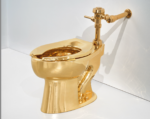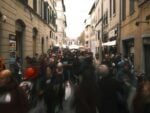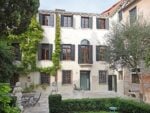Per-Oskar Leu – Before the War
.jpg)
Al centro dell’esperienza dell’artista norvegese Per-Oskar Leu vi è un particolare interesse per le rivoluzioni fallite e le battaglie perse, moralmente giuste, spesso viste attraverso opere di personaggi storici come il drammaturgo marxista Bertolt Brecht, il pittore “Comunista Cosmico” Otto Freundlich, o il pittore del XIX secolo, passato all’attivismo politico, Gustave Courbet.
Comunicato stampa
Per-Oskar Leu
Before the War
L’azione ha più voce dell’arte.
Al centro dell’esperienza dell’artista norvegese Per-Oskar Leu vi è un particolare interesse per le rivoluzioni fallite e le battaglie perse, moralmente giuste, spesso viste attraverso opere di personaggi storici come il drammaturgo marxista Bertolt Brecht, il pittore “Comunista Cosmico” Otto Freundlich, o il pittore del XIX secolo, passato all’attivismo politico, Gustave Courbet.
La terza mostra personale di Leu presso la galleria 1/9unosunove, intitolata Before the War, prende spunto dalla rivista francese “Mieux Vivre”, pubblicata mensilmente dal 1936 al 1939. “Mieux Vivre” ("Vivere Meglio") era uno strumento promozionale, delle dimensioni di un opuscolo, ideato da un’azienda farmaceutica; ogni numero conteneva un saggio accompagnato da fotografie a tema in bianco e nero realizzate da alcuni dei più famosi fotografi dell’epoca. Ma la cosa più importante per Leu è che sulla copertina di ogni numero veniva raffigurato un quadro, di vari artisti, legato all'argomento in questione e reso monocromatico nei toni del verde.
In mostra vengono presentate cinque copertine della rivista dal catalogo storico di “Mieux Vivre”, ciascuna contenente un dipinto di Gustave Courbet. Le immagini delle copertine sono stampate su tessuti di varie dimensioni in modo che l'immagine di ogni quadro corrisponda alle dimensioni della tela originale. Ad ogni tessuto è attaccata una cravatta di seta del grande sarto Charvet, applicata in modo che il logo del produttore sul retro di ogni cravatta sia rivolto verso lo spettatore, coprendo precisamente la firma dipinta di Courbet.
Charvet è il più antico produttore di camicie in Francia, con una linea di discendenza che risale alla corte di Napoleone. Nel 1877, anno della morte di un esiliato e indigente Courbet, Charvet trasferì la sua sede a Place Vendôme a Parigi, dove ancora oggi risiede insieme ad altre boutique di lusso. Per Leu, il negozio di Charvet a Place Vendôme e l'invenzione della cravatta, legata alla moda maschile della fiorente borghesia negli anni '60 dell'Ottocento, sono visti in relazione ai drammatici accadimenti che in quella stessa piazza ebbero luogo durante la Comune di Parigi del 1871. Il 16 maggio i comunardi rivoluzionari, seguendo il suggerimento che lo stesso Courbet aveva dato l'anno prima, abbatterono e distrussero la colonna eretta da Napoleone I per onorare le vittorie dell'esercito francese. Nel violento periodo successivo alla Comune, Courbet fu sia condannato alla prigionia che costretto a coprire i costi della ricostruzione della colonna Vendôme. Questi fatti alla fine portarono il pittore all'esilio volontario in Svizzera fino alla sua morte, pochi anni dopo.
Le cravatte Charvet, montate verticalmente sulle stampe tessili di Courbet/“Mieux Vivre”, sono elementi visivi che rimpiazzano la colonna Vendôme e contemporaneamente si propongono come bandiere della parte vincente nella lotta tra capitalismo e socialismo. Courbet stesso era diviso tra idealismo politico e aspettative verso l’emergente mercato dell'arte del suo tempo. Prima della guerra è un'opera di lutto, in memoria delle battaglie perdute dalla sinistra politica, e un lamento per l'apparente impossibilità di sfuggire al pantano del capitalismo. Ma, allo stesso tempo, funziona come una ricerca di una strategia artistica legittima in tempi di sconvolgimento sociale.
Arve Rød
(traduzione di Giulia Nardone)
___________________
English version
Wednesday, December 6, 2017 at 7pm
Per-Oskar Leu
Before the War
Action speaks louder than art.
At the core of Norwegian artist Per-Oskar Leu’s practice lies an interest in failed revolutions and righteous battles that were lost, often seen through the work of historical figures such as the Marxist playwright Bertolt Brecht, the “Cosmic Communist” painter Otto Freundlich, or the 19th century painter-turned-political activist Gustave Courbet.
Leu’s third solo exhibition at 1/9 unosunove, titled Before the War, takes as a point of departure the French magazine Mieux Vivre, which was published monthly between 1936 and 1939. Mieux Vivre (“Better Living”) was a booklet-sized PR tool created by a pharmaceutical company, each issue containing a written essay accompanied by themed black-and-white photographs by some of the most renowned photographers of the day. More important to Leu, pictured on the cover of each issue was a framed painting by various artists, corresponding to the topic at hand, and flattened into monochromatic shades of green.
Presented in the exhibition are five magazine covers from the Mieux Vivre back catalogue, each containing a painting by Gustave Courbet. Images of the covers are printed on textiles in various dimensions so that the image of each painting corresponds with the dimensions of the original canvas. Attached to each textile is a silk necktie from the high-end shirt maker and tailor Charvet, affixed so that the manufacturer’s logo on the backside of each tie is facing the viewer, precisely covering Courbet’s painted signature.
Charvet is the oldest shirt maker in France, with a lineage stretching back to the court of Napoleon. In 1877, the year of Courbet’s death in impoverished exile, Charvet moved its headquarters to the Place Vendôme in Paris, where it still resides among other luxury boutiques today. For Leu, Charvet’s store at the Place Vendôme, and the invention of the necktie as a men’s fashion for the burgeoning bourgeoisie in the 1860s is seen in relation to the dramatic incidents at this very same Paris square during the events of the Paris Commune in 1871. On 16 May the revolutionary Communards – following up a suggestion of Courbet the year before – pulled down and destroyed the column erected by Napoleon I to honour the victories of the French Army. In the violent aftermath of the Commune, Courbet was both sentenced to prison, and required to cover the costs of the rebuilding of the Vendôme column, which eventually led to the painter’s self imposed exile in Switzerland until his death a few years later.
The Charvet ties, mounted vertically onto the Courbet/Mieux Vivre textile prints, are visual stand-ins for the Vendôme column, and simultaneously proposed as banners of the winning side in the struggle between capitalism and socialism. Courbet himself was torn between political idealism, and the expectations of the emerging art market of his time. Before the War is a work of mourning – in memoriam of lost battles of the political left, and a lament over the seeming impossibility of escaping the quagmire of capitalism – and at the same time a search for a legitimate artistic strategy in times of social upheaval.
Arve Rød



